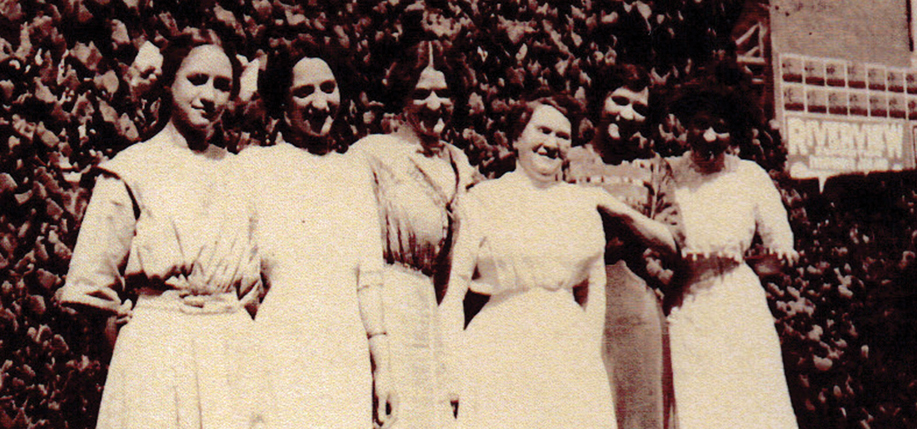In the 1960s my mother inherited a ring that had been passed down through two generations. When she began wearing the ring, just before falling asleep or upon waking, she heard the sounds of murmuring voices, clinking glasses, and muffled laughter as if there were a party going on in another part of the house. Then, a man’s insistent voice calling out, “Rose! Rose!” A few weeks later, she put the ring away and the haunting stopped.
Years afterwards she told me about the ring and the voice, but when I asked about the woman who owned the ring, my mother said all she knew was that it belonged to a relative of her grandmother, and by that time anyone who might have known more had passed away.
There were plenty of stories of my first-generation Irish-American grandparents growing up in Chicago at the turn of the last century. But when either was asked where in Ireland their parents had come from there were no answers. They truly didn’t know. So, we were left with only the bits and pieces of memorabilia – some lace and embroidered cloths, a cracked teapot carried lovingly across the ocean – and slivers of information.
My desire to find out about the ring began with my great grandmother, Cecilia Kilroy Williamson, who, I discovered, was given that ring by her cousin Joe. The ring had belonged to his mother. Along with his father’s watch, it was all he had left of his family. When Joe was three years old his parents and baby sister all died when the Lady Elgin sank in Lake Michigan in 1860 and he was left in the care of his maternal grandparents.
As a young man he moved from Milwaukee to Chicago and was reunited with his cousin Cecelia. As he’d never married, he gave those mementos to her when he was dying. So, the ring came to Cecelia with a tragic and sad story. Having had much of that in her own life, it’s no wonder it was put away and not spoken of.
Cecelia was born in New York City in 1855 to Michael Kilroy and Mary McHale, and one of the bits and pieces we had, a sampler she embroidered at age 13, revealed that in the 1860s the Kilroy family was living in Erie, Pennsylvania. Then, sometime in the 1870s she met Charles Williamson, a young British Protestant who had come down to Erie from Canada. When they married, the family story goes, Cecelia was disowned.
They moved to Chicago in the late 1870s. Charles was a cooper, or a barrel maker, and he had a brother already in Chicago who operated his own barrel factory. They eventually had ten children, seven of whom survived. Lenore, the youngest, became my grandmother. Every one of them was baptized a Catholic.
Tragedy struck in 1902 however, when Charles was killed in a factory accident. Cecelia had an emotional breakdown and was sent to a sanatorium, leaving the eldest daughters, Ella and Rose, to run the home until their mother was well enough to return. My grandmother was then four years old and her lasting memory was of losing both her parents.
Despite this hardship, there was a strong sense of service that Cecelia and Charles passed down to their children. Charles, Jr. became a Chicago fireman. Ann and Lenore studied nursing. Though Ann died of pernicious anemia during her training, Lenore graduated in 1917 and had a career as a nurse before beginning her own family of nine children. Ella became an expert milliner and Rose an excellent seamstress. All of Lenore’s daughters enjoyed the benefit of these skills in the beautiful outfits created for them every Christmas and Easter. Were these skills passed down to them from Cecelia, who might have learned them from her own mother?
In this process of my journey of discovery I did eventually find concrete information on my immigrant relatives. It turned out there was another cousin of Cecelia and Joe. She had come over from Ireland in 1868 and became a Sister of Providence. It was thus from information provided by the convent that we finally discovered the place that Michael Kilroy left all those years ago. Sister Cyril’s birth name was Sarah Kilroy and she was born in Newport, County Mayo.
The stories I heard throughout my childhood made me wish I could have gone back in time and known all of these people I came from. My mother’s ring became the place to start piecing those bits and pieces together and led to the discovery of a much fuller picture of what all those who came before us had had to endure.
– By Monica Dougherty
Monica Dougherty is the author of Rose’s Ring (Sunstone Press, 2014), a historical thriller that traverses time, interweaving Dougherty’s own family history, a tribe of native Oneida, and a runaway slave.


Leave a Reply